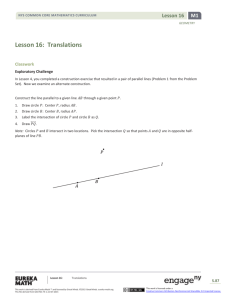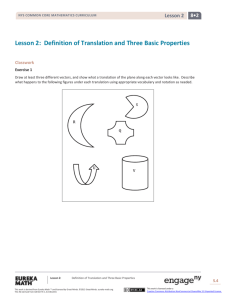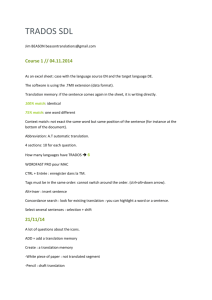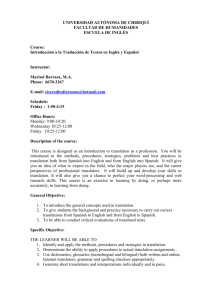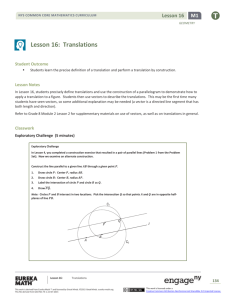Lesson 2 - EngageNY
advertisement
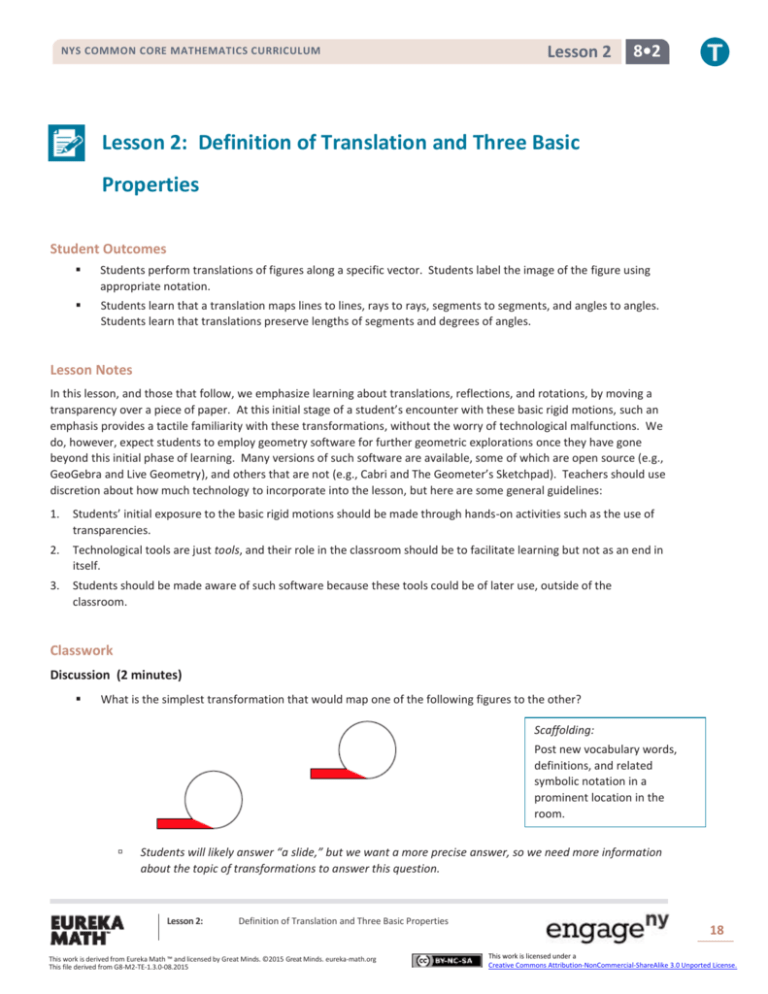
NYS COMMON CORE MATHEMATICS CURRICULUM Lesson 2 8•2 Lesson 2: Definition of Translation and Three Basic Properties Student Outcomes Students perform translations of figures along a specific vector. Students label the image of the figure using appropriate notation. Students learn that a translation maps lines to lines, rays to rays, segments to segments, and angles to angles. Students learn that translations preserve lengths of segments and degrees of angles. Lesson Notes In this lesson, and those that follow, we emphasize learning about translations, reflections, and rotations, by moving a transparency over a piece of paper. At this initial stage of a student’s encounter with these basic rigid motions, such an emphasis provides a tactile familiarity with these transformations, without the worry of technological malfunctions. We do, however, expect students to employ geometry software for further geometric explorations once they have gone beyond this initial phase of learning. Many versions of such software are available, some of which are open source (e.g., GeoGebra and Live Geometry), and others that are not (e.g., Cabri and The Geometer’s Sketchpad). Teachers should use discretion about how much technology to incorporate into the lesson, but here are some general guidelines: 1. Students’ initial exposure to the basic rigid motions should be made through hands-on activities such as the use of transparencies. 2. Technological tools are just tools, and their role in the classroom should be to facilitate learning but not as an end in itself. 3. Students should be made aware of such software because these tools could be of later use, outside of the classroom. Classwork Discussion (2 minutes) What is the simplest transformation that would map one of the following figures to the other? Scaffolding: Post new vocabulary words, definitions, and related symbolic notation in a prominent location in the room. Students will likely answer “a slide,” but we want a more precise answer, so we need more information about the topic of transformations to answer this question. Lesson 2: Definition of Translation and Three Basic Properties This work is derived from Eureka Math ™ and licensed by Great Minds. ©2015 Great Minds. eureka-math.org This file derived from G8-M2-TE-1.3.0-08.2015 18 This work is licensed under a Creative Commons Attribution-NonCommercial-ShareAlike 3.0 Unported License. Lesson 2 NYS COMMON CORE MATHEMATICS CURRICULUM 8•2 In the next few lessons, we learn about three kinds of simple rigid motions: translation, reflection, and rotation. We call these the basic rigid motions. We use the term basic because students see that every rigid motion can be obtained by a suitable sequence (see: Topic B) of translations, reflections, and rotations.1 In the following, we describe how to move a transparency over a piece of paper to demonstrate the effect each of these basic rigid motions has on the points in the plane. We begin with translations or, more precisely, a translation along a given vector. Example 1 (3 minutes) Before explaining explicitly what translation along a vector is, review the question that started the discussion. Then, draw a vector, and demonstrate how to translate along the chosen vector to map the lower left figure to the upper right figure. Scaffolding: Consider showing several examples of vectors that can be used instead of just one. A vector is a directed line segment, that is, it is a segment with a direction given by connecting one of its endpoint (called the initial point or starting point) to the other endpoint (called the terminal point or simply the endpoint). It is often represented as an “arrow” with a “tail” and a “tip.” – The length of a vector is, by definition, the length of its underlying segment. – Visually, we distinguish a vector from its underlying segment by adding an arrow above the symbol. Thus, if the segment is 𝐴𝐵 (𝐴 and 𝐵 being its endpoints), then the vector with starting point 𝐴 and endpoint 𝐵 is denoted by ⃗⃗⃗⃗⃗ 𝐴𝐵 . Likewise, the vector with starting point 𝐵 and endpoint 𝐴 is denoted by ⃗⃗⃗⃗⃗ 𝐵𝐴. – Note that the arrowhead on the endpoint of a vector distinguishes it from the starting point. Here, vector ⃗⃗⃗⃗⃗ 𝐴𝐵 is on the left, and vector ⃗⃗⃗⃗⃗ 𝐵𝐴 is on the right. 1Strictly speaking, all we need are reflections because rotations and translations can be shown to be compositions of reflections. However, for the purpose of fostering geometric intuition, we should employ all three. Lesson 2: Definition of Translation and Three Basic Properties This work is derived from Eureka Math ™ and licensed by Great Minds. ©2015 Great Minds. eureka-math.org This file derived from G8-M2-TE-1.3.0-08.2015 19 This work is licensed under a Creative Commons Attribution-NonCommercial-ShareAlike 3.0 Unported License. Lesson 2 NYS COMMON CORE MATHEMATICS CURRICULUM 8•2 Example 2 (4 minutes) We are going to describe how to define a translation 𝑇 along a vector ⃗⃗⃗⃗⃗ 𝐴𝐵 by the use of an overhead projector transparency. Let the plane be represented by a piece of paper on which the vector ⃗⃗⃗⃗⃗ 𝐴𝐵 has been drawn. Let 𝑃 be an arbitrary point in the plane (i.e., the paper), as shown. Note that the line containing the vector ⃗⃗⃗⃗⃗ 𝐴𝐵 , to be denoted by 𝐿𝐴𝐵 , is represented by the dotted line segment in the following picture. Note, also, that we are using a finite rectangle to represent the plane, which is infinite in all directions, and a finite segment to represent a line, which is infinite in both directions. The rectangle in the picture below represents the border of the piece of paper. Now trace ⃗⃗⃗⃗⃗ 𝐴𝐵 , the line 𝐿𝐴𝐵 , and the point 𝑃 exactly on an overhead projector transparency (of exactly the same size as the paper) using a different color, say red. Then, 𝑃 becomes the red dot on the transparency, and ⃗⃗⃗⃗⃗ 𝐴𝐵 becomes a red vector on the transparency; we shall refer to them as the red dot and red vector, respectively, in this example. Keeping the paper fixed, we slide the transparency along ⃗⃗⃗⃗⃗ 𝐴𝐵 , moving the transparency in the direction from 𝐴 to 𝐵, so that the red vector on the transparency stays on the line 𝐿𝐴𝐵 , until the starting point of the red vector rests on the endpoint 𝐵 of the vector ⃗⃗⃗⃗⃗ 𝐴𝐵 , as shown in the picture. In other words, we slide the transparency along the line 𝐴𝐵, in the direction from 𝐴 to 𝐵, for a distance equal to the length of the vector ⃗⃗⃗⃗⃗ 𝐴𝐵 . The picture shows the transparency after it has been slid along ⃗⃗⃗⃗⃗ 𝐴𝐵 , and the red rectangle represents the border of the transparency. The point of the plane at the red dot is, by definition, the image 𝑇𝑟𝑎𝑛𝑠𝑙𝑎𝑡𝑖𝑜𝑛(𝑃) of 𝑃 by the translation 𝑇. If we need to be precise, we denote the translation along ⃗⃗⃗⃗⃗ 𝐴𝐵 by 𝑇𝑟𝑎𝑛𝑠𝑙𝑎𝑡𝑖𝑜𝑛⃗⃗⃗⃗⃗ . There is some subtlety in this notation: the vector ⃗⃗⃗⃗⃗ 𝐴𝐵 has 𝐴𝐵 the starting point 𝐴 and endpoint 𝐵, but the vector ⃗⃗⃗⃗⃗ 𝐵𝐴 has the starting point 𝐵 and endpoint 𝐴. Thus, 𝑇𝑟𝑎𝑛𝑠𝑙𝑎𝑡𝑖𝑜𝑛𝐴𝐵 is different from 𝑇𝑟𝑎𝑛𝑠𝑙𝑎𝑡𝑖𝑜𝑛⃗⃗⃗⃗⃗ ⃗⃗⃗⃗⃗ 𝐵𝐴 . Precisely: MP.4 𝑇𝑟𝑎𝑛𝑠𝑙𝑎𝑡𝑖𝑜𝑛⃗⃗⃗⃗⃗ 𝐴𝐵 (𝐴) = 𝐵 but 𝑇𝑟𝑎𝑛𝑠𝑙𝑎𝑡𝑖𝑜𝑛⃗⃗⃗⃗⃗ 𝐵𝐴 (𝐵) = 𝐴. (1) Video Presentation (2 minutes) The following animation2 of a translation would be helpful to a beginner: http://www.harpercollege.edu/~skoswatt/RigidMotions/translation.html 2Video Note to Teacher: In reading the descriptions about what translation does, please bear in mind that, in the classroom, a face-to-face demonstration with transparency and paper is far easier to understand than the verbal descriptions given in this lesson. developed by Sunil Koswatta. Lesson 2: Definition of Translation and Three Basic Properties This work is derived from Eureka Math ™ and licensed by Great Minds. ©2015 Great Minds. eureka-math.org This file derived from G8-M2-TE-1.3.0-08.2015 20 This work is licensed under a Creative Commons Attribution-NonCommercial-ShareAlike 3.0 Unported License. NYS COMMON CORE MATHEMATICS CURRICULUM Lesson 2 8•2 Example 3 (4 minutes) Suppose we are given a geometric figure consisting of a vertical line 𝐿 and two points, as shown. We are going to describe the effect on this figure when we translate the plane along the blue vector. Again, we copy the whole figure on a transparency in red and then slide the transparency along the blue vector. The whole figure is translated so that the red vertical line and the red dots are in the picture on the right. By definition, the translation 𝑇 maps the black dots to the red dots, and similarly, 𝑇 maps a typical point 𝑈 on the vertical black line (represented by a tiny circle) to the point 𝑇(𝑈). If we draw the translated figure by itself without reference to the original, it is visually indistinguishable from the original. Scaffolding: So, we put back the original black figure as background information to show where the red figure used to be. The dashed arrows should suggest the assignment by the translation 𝑇. Lesson 2: Definition of Translation and Three Basic Properties This work is derived from Eureka Math ™ and licensed by Great Minds. ©2015 Great Minds. eureka-math.org This file derived from G8-M2-TE-1.3.0-08.2015 In this lesson, we try to be clear and, therefore, must define and use terminology precisely. However, in the classroom, it can sometimes be easier to point to the picture without using any definition, at least for a while. Introduce the terminology gradually, repeat often, and remind students of the meaning of the new words. 21 This work is licensed under a Creative Commons Attribution-NonCommercial-ShareAlike 3.0 Unported License. Lesson 2 NYS COMMON CORE MATHEMATICS CURRICULUM 8•2 Example 4 (4 minutes) We now make some observations about the basic properties of translations. We have covered how a translation 𝑇 along a vector maps some point 𝑃 to a point 𝑇(𝑃). Now, we examine what 𝑇 does to the total collection of points in a given figure. We have actually done that implicitly because the red vertical line in Example 2 is the totality of all the points 𝑇(𝑈) where 𝑈 is a point on the black vertical line 𝐿. For obvious reasons, we denote the red line by 𝑇(𝐿). More formally, if 𝐺 is a given figure in the plane, then we denote by 𝑇(𝐺) the collection of all the points 𝑇(𝑃), where 𝑃 is a point in 𝐺. We call 𝑇(𝐺) the image of 𝐺 by 𝑇, and (as in the case of a point) we also say that 𝑇 maps 𝐺 to 𝑇(𝐺). The diagram to the right shows a translation of a figure along the blue vector ⃗⃗⃗⃗⃗ 𝐴𝐵 . If 𝐺 is the black figure, then 𝑇(𝐺) is the red figure, as shown. MP.6 𝑇(𝐿) 𝑇(𝐺) 𝐵 𝐴 𝐺 Prime notation is introduced to students in Grade 7, Module 6, Topic B, Lesson 8. Briefly remind students of this notation using the diagram below. The notation to represent the image of a point can become cumbersome. However, there are ways to denote the image of the translated points using a more simplified notation. For example, point 𝑂 after the translation can be denoted by 𝑂′, said as “𝑂 prime”; point 𝑃 is denoted by 𝑃′, said as “𝑃 prime”; and point 𝑄 is denoted by 𝑄′, said as “𝑄 prime.” Lesson 2: Definition of Translation and Three Basic Properties This work is derived from Eureka Math ™ and licensed by Great Minds. ©2015 Great Minds. eureka-math.org This file derived from G8-M2-TE-1.3.0-08.2015 22 This work is licensed under a Creative Commons Attribution-NonCommercial-ShareAlike 3.0 Unported License. NYS COMMON CORE MATHEMATICS CURRICULUM Lesson 2 8•2 Exercise 1 (5 minutes) Students complete Exercise 1 in pairs to practice translating a figure along various vectors. Students should describe to their partners what is happening in the translation in order to practice using the vocabulary and notation related to translations. (Note: Students are translating a curved figure because figures that consist entirely of line segments can be reproduced elsewhere on the plane by using a ruler and measuring lengths and degrees of angles, without the use of translation. This defeats the purpose of teaching the concept of translation to move figures around the plane.) Circulate to check student work. Also, consider calling on students to share their work with the class. Exercise 1 Draw at least three different vectors, and show what a translation of the plane along each vector looks like. Describe what happens to the following figures under each translation using appropriate vocabulary and notation as needed. Answers will vary. Exercise 2 (4 minutes) Now, students translate specific geometric figures (i.e., lines, angles, segments, and points). They should use prime notation and record their observations as to the lengths of segments and sizes of angles as they complete Exercise 2 independently. Lesson 2: Definition of Translation and Three Basic Properties This work is derived from Eureka Math ™ and licensed by Great Minds. ©2015 Great Minds. eureka-math.org This file derived from G8-M2-TE-1.3.0-08.2015 23 This work is licensed under a Creative Commons Attribution-NonCommercial-ShareAlike 3.0 Unported License. NYS COMMON CORE MATHEMATICS CURRICULUM Lesson 2 8•2 Exercise 2 The diagram below shows figures and their images under a translation along ⃗⃗⃗⃗⃗ 𝑯𝑰. Use the original figures and the translated images to fill in missing labels for points and measures. Solutions are in red, below. Discussion (10 minutes) A translation maps lines to lines, segments to segments, and points to points. Do you believe it? A translation preserves lengths of segments. Do you believe it? In general, if 𝐴 and 𝐵 are any two points in the plane, then the distance between 𝐴 and 𝐵 is, by definition, the length of the segment joining 𝑇𝑟𝑎𝑛𝑠𝑙𝑎𝑡𝑖𝑜𝑛(𝐴) and 𝑇𝑟𝑎𝑛𝑠𝑙𝑎𝑡𝑖𝑜𝑛(𝐵). Therefore, translations are distance-preserving as shown in Lesson 1, and translations are examples of rigid motions. Translations map angles to angles. Do you believe it? MP.2 & MP.6 Yes. After the translation, line 𝐹𝐺 was still a line, segment 𝐷𝐸 was still a segment, and the points were still points. Yes. The segment 𝐷𝐸 in Exercise 2 was the same length after the translation as it was originally. Yes. After the translation, angle 𝐴𝐵𝐶 in Exercise 2 was still an angle. Its shape did not change. A translation preserves the degree of an angle. Do you believe it? Yes. After the translation, angle 𝐴𝐵𝐶 in Exercise 2 was still 31˚. Its size did not change. Lesson 2: Definition of Translation and Three Basic Properties This work is derived from Eureka Math ™ and licensed by Great Minds. ©2015 Great Minds. eureka-math.org This file derived from G8-M2-TE-1.3.0-08.2015 24 This work is licensed under a Creative Commons Attribution-NonCommercial-ShareAlike 3.0 Unported License. NYS COMMON CORE MATHEMATICS CURRICULUM Lesson 2 8•2 The following are some basic properties of translations: (Translation 1) A translation maps a line to a line, a ray to a ray, a segment to a segment, and an angle to an angle. (Translation 2) A translation preserves lengths of segments. (Translation 3) A translation preserves degrees of angles. These basic properties of translations are taken for granted in all subsequent discussions of geometry. There are two more points to make about the effect a translation can have on points and lines. How can we describe the image of an arbitrary point 𝐶 by a translation relative to 𝐶 and the translation itself? In other words, is there a relationship between 𝐶, its image 𝐶′, and the vector 𝐶 is translated along? Let 𝑇 be the translation along a given vector ⃗⃗⃗⃗⃗ 𝐴𝐵 . If we slide a transparency along the vector ⃗⃗⃗⃗⃗ 𝐴𝐵 , it is plausible ⃗⃗⃗⃗⃗⃗ points in the same direction as the vector ⃗⃗⃗⃗⃗ that 𝐶 moves to a point 𝐶′ so that the vector 𝐶𝐶′ 𝐴𝐵 , and the length of the segment 𝐶𝐶′ is the same length as the segment 𝐴𝐵. Let’s accept these conclusions at this point. Here is a pictorial representation of this situation for the case where 𝐶 does not lie on the line 𝐿𝐴𝐵 : To clarify, the statement “vector ⃗⃗⃗⃗⃗⃗ 𝐶𝐶′ points in the same direction as the vector ⃗⃗⃗⃗⃗ 𝐴𝐵 ” means that the point 𝐶′ is moved as shown in the picture to the left below, rather than as shown in the picture to the right. Still assuming that 𝐶 is not a point on line 𝐿𝐴𝐵 , observe from the definition of a translation (in terms of sliding a transparency) that the line 𝐿𝐶𝐶 ′ is parallel to the line 𝐿𝐴𝐵 . This is because the point 𝐶 on the transparency is not on the blue line 𝐿𝐴𝐵 on the transparency. Therefore, as we slide the line 𝐿𝐴𝐵 on the transparency along the original 𝐿𝐴𝐵 , the point 𝐶 stays away from the original 𝐿𝐴𝐵 . For this reason, the point 𝐶 traces out the line 𝐿𝐶𝐶 ′ and has no point in common with the original 𝐿𝐴𝐵 . In other words, 𝐿𝐶𝐶 ′ ∥ 𝐿𝐴𝐵 . If 𝐶 is a point on the line 𝐿𝐴𝐵 , then 𝐶′ is also a point on the line 𝐿𝐴𝐵 , and in this case, 𝐿𝐶𝐶 ′ coincides with the line 𝐿𝐴𝐵 rather than being parallel to the line 𝐿𝐴𝐵 . Our preliminary findings, summarized below, are the basis for the descriptive definition of translation (see the terminology below the Lesson Summary): Let 𝑇 be the translation along ⃗⃗⃗⃗⃗ 𝐴𝐵 . Let 𝐶 be a point in the plane, and let the image 𝑇(𝐶) be denoted by 𝐶 ′ . Then, the vector ⃗⃗⃗⃗⃗⃗ 𝐶𝐶′ points in the same direction as ⃗⃗⃗⃗⃗ 𝐴𝐵 , and the vectors have the same length. If 𝐶 lies on line 𝐿𝐴𝐵 , then so does 𝐶′. If 𝐶 does not lie on 𝐿𝐴𝐵 , then 𝐿𝐶𝐶 ′ ∥ 𝐿𝐴𝐵 . Lesson 2: Definition of Translation and Three Basic Properties This work is derived from Eureka Math ™ and licensed by Great Minds. ©2015 Great Minds. eureka-math.org This file derived from G8-M2-TE-1.3.0-08.2015 25 This work is licensed under a Creative Commons Attribution-NonCommercial-ShareAlike 3.0 Unported License. NYS COMMON CORE MATHEMATICS CURRICULUM Lesson 2 8•2 Closing (3 minutes) Summarize, or have students summarize, the lesson. We now know what a translation of a plane along a vector is. We know where a point, a line, or a figure on a plane moves to by a translation along a given vector. We know that translations have three basic properties: – Translations map lines to lines, segments to segments, rays to rays, and angles to angles. – Lengths of segments are preserved. – Degrees of measures of angles are preserved. We can now use a simplified notation, for example, 𝑃′ to represent the translated point 𝑃. Lesson Summary Translation occurs along a given vector: A vector is a directed line segment, that is, it is a segment with a direction given by connecting one of its endpoint (called the initial point or starting point) to the other endpoint (called the terminal point or simply the endpoint). It is often represented as an “arrow” with a “tail” and a “tip.” The length of a vector is, by definition, the length of its underlying segment. Pictorially note the starting and endpoints: A translation of a plane along a given vector is a basic rigid motion of a plane. The three basic properties of translation are as follows: (Translation 1) A translation maps a line to a line, a ray to a ray, a segment to a segment, and an angle to an angle. (Translation 2) A translation preserves lengths of segments. (Translation 3) A translation preserves measures of angles. Terminology TRANSLATION (description): For vector ⃗⃗⃗⃗⃗⃗ 𝑨𝑩, a translation along ⃗⃗⃗⃗⃗⃗ 𝑨𝑩 is the transformation of the plane that maps each ′ point 𝑪 of the plane to its image 𝑪 so that the line ⃡⃗⃗⃗⃗⃗ 𝑪𝑪′ is parallel to the vector (or contains it), and the vector ⃗⃗⃗⃗⃗⃗ 𝑪𝑪′ ⃗⃗⃗⃗⃗⃗ points in the same direction and is the same length as the vector 𝑨𝑩. Exit Ticket (4 minutes) Lesson 2: Definition of Translation and Three Basic Properties This work is derived from Eureka Math ™ and licensed by Great Minds. ©2015 Great Minds. eureka-math.org This file derived from G8-M2-TE-1.3.0-08.2015 26 This work is licensed under a Creative Commons Attribution-NonCommercial-ShareAlike 3.0 Unported License. Lesson 2 NYS COMMON CORE MATHEMATICS CURRICULUM Name 8•2 Date Lesson 2: Definition of Translation and Three Basic Properties Exit Ticket 1. Name the vector in the picture below. 2. Name the vector along which a translation of a plane would map point 𝐴 to its image 𝑇(𝐴). 3. Is Maria correct when she says that there is a translation along a vector that maps segment 𝐴𝐵 to segment 𝐶𝐷? If so, draw the vector. If not, explain why not. 4. Assume there is a translation that maps segment 𝐴𝐵 to segment 𝐶𝐷 shown above. If the length of segment 𝐶𝐷 is 8 units, what is the length of segment 𝐴𝐵? How do you know? Lesson 2: Definition of Translation and Three Basic Properties This work is derived from Eureka Math ™ and licensed by Great Minds. ©2015 Great Minds. eureka-math.org This file derived from G8-M2-TE-1.3.0-08.2015 27 This work is licensed under a Creative Commons Attribution-NonCommercial-ShareAlike 3.0 Unported License. Lesson 2 NYS COMMON CORE MATHEMATICS CURRICULUM 8•2 Exit Ticket Sample Solutions 1. Name the vector in the picture below. ⃗⃗⃗⃗⃗⃗ 𝑸𝑷 2. Name the vector along which a translation of a plane would map point 𝑨 to its image 𝑻(𝑨). ⃗⃗⃗⃗⃗ 𝑺𝑹 3. Is Maria correct when she says that there is a translation along a vector that maps segment 𝑨𝑩 to segment 𝑪𝑫? If so, draw the vector. If not, explain why not. Yes. Accept any vector that would translate the segment 𝑨𝑩 to segment 𝑪𝑫. A possible vector is shown in red, above. 4. Assume there is a translation that maps segment 𝑨𝑩 to segment 𝑪𝑫 shown above. If the length of segment 𝑪𝑫 is 𝟖 units, what is the length of segment 𝑨𝑩? How do you know? The length of 𝑪𝑫 must be 𝟖 units in length because translations preserve the lengths of segments. Lesson 2: Definition of Translation and Three Basic Properties This work is derived from Eureka Math ™ and licensed by Great Minds. ©2015 Great Minds. eureka-math.org This file derived from G8-M2-TE-1.3.0-08.2015 28 This work is licensed under a Creative Commons Attribution-NonCommercial-ShareAlike 3.0 Unported License. Lesson 2 NYS COMMON CORE MATHEMATICS CURRICULUM 8•2 Problem Set Sample Solutions 1. Translate the plane containing Figure 𝑨 along ⃗⃗⃗⃗⃗⃗ 𝑨𝑩. Use your transparency to sketch the image of Figure 𝑨 by this translation. Mark points on Figure 𝑨, and label the image of Figure 𝑨 accordingly. Marked points will vary. Verify that students have labeled their points and images appropriately. 2. ⃗⃗⃗⃗⃗⃗ . Use your transparency to sketch the image of Figure 𝑩 by this Translate the plane containing Figure 𝑩 along 𝑩𝑨 translation. Mark points on Figure 𝑩, and label the image of Figure 𝑩 accordingly. Marked points will vary. Verify that students have labeled their points and images appropriately. 3. Draw an acute angle (your choice of degree), a segment with length 𝟑 𝐜𝐦, a point, a circle with radius 𝟏 𝐢𝐧., and a vector (your choice of length, i.e., starting point and ending point). Label points and measures (measurements do not need to be precise, but your figure must be labeled correctly). Use your transparency to translate all of the figures you have drawn along the vector. Sketch the images of the translated figures and label them. Drawings will vary. Note: Drawing is not to scale. Lesson 2: Definition of Translation and Three Basic Properties This work is derived from Eureka Math ™ and licensed by Great Minds. ©2015 Great Minds. eureka-math.org This file derived from G8-M2-TE-1.3.0-08.2015 29 This work is licensed under a Creative Commons Attribution-NonCommercial-ShareAlike 3.0 Unported License. NYS COMMON CORE MATHEMATICS CURRICULUM 4. Lesson 2 8•2 What is the length of the translated segment? How does this length compare to the length of the original segment? Explain. The length is 𝟑 𝐜𝐦. The length is the same as the original because translations preserve the lengths of segments. 5. What is the length of the radius in the translated circle? How does this radius length compare to the radius of the original circle? Explain. The length is 𝟏 𝐢𝐧. The length is the same as the original because translations preserve lengths of segments. 6. What is the degree of the translated angle? How does this degree compare to the degree of the original angle? Explain. Answers will vary based on the original size of the angle drawn. The angles will have the same measure because translations preserve degrees of angles. 7. ⃗⃗⃗⃗⃗⃗ , and label the image 𝑫′. What do you notice about the line containing vector 𝑨𝑩 ⃗⃗⃗⃗⃗⃗ Translate point 𝑫 along vector 𝑨𝑩 and the line containing points 𝑫 and 𝑫′? (Hint: Will the lines ever intersect?) The lines will be parallel. 8. ⃗⃗⃗⃗⃗⃗ , and label the image 𝑬′. What do you notice about the line containing vector 𝑨𝑩 ⃗⃗⃗⃗⃗⃗ Translate point 𝑬 along vector 𝑨𝑩 and the line containing points 𝑬 and 𝑬′? The lines will coincide. Lesson 2: Definition of Translation and Three Basic Properties This work is derived from Eureka Math ™ and licensed by Great Minds. ©2015 Great Minds. eureka-math.org This file derived from G8-M2-TE-1.3.0-08.2015 30 This work is licensed under a Creative Commons Attribution-NonCommercial-ShareAlike 3.0 Unported License.

